NGC 4631 is a barred spiral galaxy in the constellation Canes Venatici about 30 million light years away from Earth. It was discovered on 20 March 1787 by German-British astronomer William Herschel. This galaxy's slightly distorted wedge shape gives it the appearance of a herring or a whale, hence its nickname. Because this nearby galaxy is seen edge-on from Earth, professional astronomers observe this galaxy to better understand the gas and stars located outside the plane of the galaxy.

Messier 90 is an intermediate spiral galaxy exhibiting a weak inner ring structure about 60 million light-years away[a] in the constellation Virgo. It was discovered by Charles Messier in 1781.

The Antennae Galaxies are a pair of interacting galaxies in the constellation Corvus. They are currently going through a starburst phase, in which the collision of clouds of gas and dust, with entangled magnetic fields, causes rapid star formation. They were discovered by William Herschel in 1785.

NGC 1532, also known as Haley's Coronet, is an edge-on barred spiral galaxy located approximately 50 million light-years from the Solar System in the constellation Eridanus. The galaxy was discovered by James Dunlop on 29 October 1826.

NGC 1512 is a barred spiral galaxy approximately 38 million light-years away from Earth in the constellation Horologium. The galaxy displays a double ring structure, with a (nuclear) ring around the galactic nucleus and an (inner) further out in the main disk. The galaxy hosts an extended UV disc with at least 200 clusters with recent star formation activity. NGC 1512 is a member of the Dorado Group.
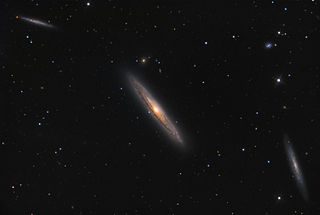
NGC 4216 is a metal-rich intermediate spiral galaxy located not far from the center of the Virgo Cluster of galaxies, roughly 55 million light-years away. It was discovered by German-British astronomer William Herschel on 17 April 1784.

NGC 1232, also known as the Eye of God Galaxy is an intermediate spiral galaxy about 60 million light-years away in the constellation Eridanus. It was discovered by German-British astronomer William Herschel on 20 October 1784.
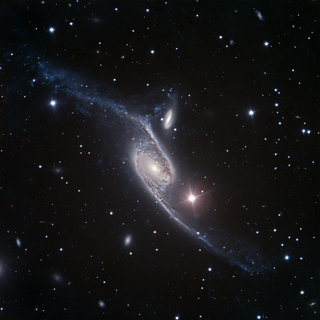
NGC 6872, also known as the Condor Galaxy, is a large barred spiral galaxy of type SB(s)b pec in the constellation Pavo. It is 212 million light-years (65 Mpc) from Earth. NGC 6872 is interacting with the lenticular galaxy IC 4970, which is less than one twelfth as large. The galaxy has two elongated arms with a diameter based on ultraviolet light of over 522,000 light-years (160,000 pc), and a D25.5 isophotal diameter of over 717,000 light-years (220,000 pc), making it the largest known spiral galaxy. It was discovered on 27 June 1835 by English astronomer John Herschel.
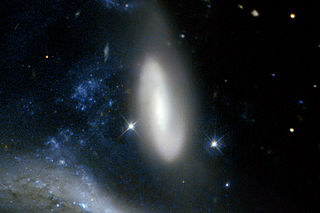
IC 4970 is an unbarred lenticular galaxy of type SA0^- pec: in the constellation Pavo. It is 212 million light-years (65 Mpc) from Earth and is interacting with the barred spiral galaxy NGC 6872. It was discovered on 21 September 1900 by American astronomer DeLisle Stewart.

NGC 5907 is a spiral galaxy located approximately 50 million light years from Earth. William Herschel discovered the galaxy in 1788.

NGC 4911 is a disturbed, warped spiral galaxy with a bright prominent central starburst ring and located deep within the Coma Cluster of galaxies, which lies some 300 million light years away in the northern constellation Coma Berenices. NGC 4911 is believed to be interacting with its warped, barred lenticular companion, producing the enhanced star formation and shell-like appearance seen in optical images. The galaxy contains rich lanes of dust and gas near its centre. The existence of clouds of hydrogen within the galaxy indicates ongoing star formation. It is rare for a spiral galaxy to be situated at the heart of a cluster.

NGC 428 is a barred spiral galaxy in the constellation of Cetus, with its spiral structure distorted and warped, possibly the result of the collision of two galaxies. There appears to be a substantial amount of star formation occurring within NGC 428 and it lacks well defined arms — a telltale sign of a galaxy merger. In 2015 the Hubble Space Telescope made a close-up shot of the galaxy with its Advanced Camera for Surveys and its Wide Field and Planetary Camera 2. The structure of NGC 428 has been compared to NGC 5645.

NGC 4647 is an intermediate spiral galaxy estimated to be around 63 million light-years away in the constellation of Virgo. It was discovered by astronomer William Herschel on March 15, 1784. NGC 4647 is listed along with Messier 60 as being part of a pair of galaxies called Arp 116; their designation in Halton Arp's Atlas of Peculiar Galaxies. The galaxy is located on the outskirts of the Virgo Cluster.

NGC 1510 is a dwarf lenticular galaxy approximately 38 million light-years away from Earth in the constellation of Horologium. It was discovered by John Herschel on December 4, 1836.

NGC 4522 is an edge-on spiral galaxy located about 60 million light-years away within the Virgo Cluster in the constellation Virgo. NGC 4522 is losing its molecular gas though ram-pressure stripping as it plows though the cluster at a speed of more than 10 million kilometres per hour. The galaxy was discovered by astronomer John Herschel on January 18, 1828.
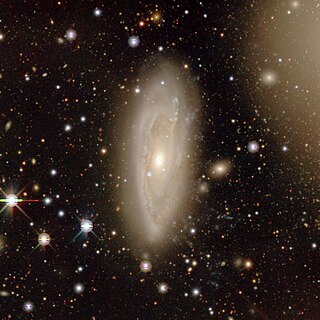
NGC 3312 is a large and highly inclined spiral galaxy located about 194 million light-years away in the constellation Hydra. The galaxy was discovered by astronomer John Herschel on March 26, 1835. It was later rediscovered by astronomer Guillaume Bigourdan on February 26, 1887. NGC 3312 was later listed and equated with IC 629 because the two objects share essentially the same celestial coordinates. NGC 3312 is the largest spiral galaxy in the Hydra Cluster and is also classified as a LINER galaxy.
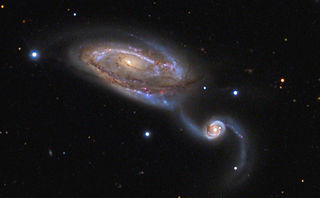
NGC 5395 is an interacting spiral galaxy located at a distance of 160 million light years, but receding away from the Earth at 3511 kilometers per second, in the constellation Canes Venatici. It was discovered by William Herschel on May 16, 1787. NGC 5395 and NGC 5394 are included in the Atlas of Peculiar Galaxies as Arp 84 in the category "Spiral galaxies with large high surface brightness companions".

NGC 6621 is an interacting spiral galaxy in the constellation Draco. It lies at a distance of about 260 million light-years. NGC 6621 interacts with NGC 6622, with their closest approach having taken place about 100 million years ago. The pair was discovered by Edward D. Swift and Lewis A. Swift on June 2, 1885. Originally NGC 6621 was assigned to the southeast galaxy, but now it refers to the northern one. NGC 6621 and NGC 6622 are included in the Atlas of Peculiar Galaxies as Arp 81 in the category "spiral galaxies with large high surface brightness companions".

NGC 4305 is a dwarf spiral galaxy located about 100 million light-years away in the constellation Virgo. The galaxy was discovered by astronomer John Herschel on May 2, 1829. Although considered to be a member of the Virgo Cluster, its high radial velocity and blue luminosity suggest it is in fact a background galaxy. The galaxy has a nearby major companion; NGC 4306.
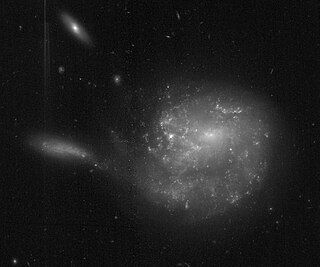
NGC 3445 is a Magellanic spiral galaxy in the constellation Ursa Major. The galaxy lies about 75 million light years away from Earth, which means, given its apparent dimensions, that NGC 3445 is approximately 35,000 light years across. It was discovered by William Herschel on April 8, 1793.



















